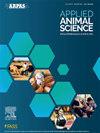The effects of 5 different implant programs on the health outcomes, growth performance, and carcass characteristics of lightweight beef steers
IF 1.5
Q3 AGRICULTURE, DAIRY & ANIMAL SCIENCE
引用次数: 0
Abstract
Objective
Our objective was to evaluate 5 different implant programs on the health outcomes, growth performance, and carcass characteristics of lightweight beef steers.
Materials and Methods
Crossbred steers (n = 3,817; initial BW 195 ± 1.1 kg) were used in a randomized complete block design and fed to a common number of days on feed (280 d). Steers were blocked by time of arrival (n = 10 blocks) and assigned randomly to 1 of 5 treatments: (1) 200 mg of trenbolone acetate (TBA) and 40 mg of estradiol 17β administered on d 0 (XS0); (2) 200 mg of TBA and 40 mg of estradiol 17β administered on d 60 (XS60); (3) 200 mg of TBA and 40 mg of estradiol 17β administered on d 80 (XS80); (4) 200 mg of TBA and 40 mg of estradiol 17β administered on d 100 (XS100); and (5) 80 mg of TBA and 16 mg of estradiol 17β administered on d 0 followed by 200 mg of TBA and 40 mg of estradiol 17β administered on d 80 (IS-XS).
Results and Discussion
The proportion of steers treated once for bovine respiratory disease was less in XS60 and XS100 than XS0, XS80, and IS-XS. No difference was noted in mortality among treatments. Steers in XS0 and IS-XS had greater DMI than XS60, XS80, and XS100. Gain:feed differed among treatment, in which XS60, XS80, and XS100 had greater G:F than XS0 and IS-XS, both with dead and removed steers included and excluded. No differences were observed in carcass traits, except in fat thickness, marbling, and estimated empty body fat, indicating that implant timing influences carcass characteristics.
Implications and Applications
In steers fed more than 220 d, delaying Revalor-XS for 60 or 80 d after arrival does not differ from using a reimplant strategy in which Revalor-IS was followed by Revalor-XS or administering Revalor-XS on d 0. Delayed implantation with an extended-release implant can meet new US Food and Drug Administration guidelines without negatively affecting growth performance or carcass quality.
5种不同的植入方案对轻质肉牛健康结果、生长性能和胴体特性的影响
我们的目的是评估5种不同的植入方案对轻质肉牛的健康结果、生长性能和胴体特性的影响。材料与方法采用完全随机区组设计,选用初始体重195±1.1 kg的杂交阉牛(n = 3,817),饲喂相同天数的饲料(280 d)。按到达时间(n = 10个时段)将受试者随机分配到5个治疗组中的1个:(1)在第0天(x0)给予200 mg醋酸trenbolone (TBA)和40 mg雌二醇17β;(2) 60 d给予TBA 200 mg和雌二醇17β 40 mg (XS60);(3) 80 d给予TBA 200 mg和雌二醇17β 40 mg (XS80);(4) 100 d给予TBA 200 mg和雌二醇17β 40 mg (XS100);(5)第0天给予TBA 80 mg和雌二醇17β 16 mg,第80天给予TBA 200 mg和雌二醇17β 40 mg (IS-XS)。结果与讨论XS60和XS100的牛呼吸道疾病治疗率低于XS80和IS-XS。两种治疗方法的死亡率没有差异。x50和IS-XS的转向器的DMI大于XS60、XS80和XS100。增重比在不同处理之间存在差异,在包括和不包括死牛和切除牛的情况下,XS60、XS80和XS100的G:F均大于XS0和IS-XS。除了脂肪厚度、大理石纹和估计的空体脂肪外,在胴体性状上没有观察到差异,这表明植入时间影响胴体特征。对于饲喂超过220 d的转向犬,在到达后延迟60或80 d使用revor - xs与使用重新种植策略(在revor - is之后使用revor - xs或在第0天使用revor - xs)没有区别。延迟植入缓释植入物可以满足美国食品和药物管理局的新指南,而不会对生长性能或胴体质量产生负面影响。
本文章由计算机程序翻译,如有差异,请以英文原文为准。
求助全文
约1分钟内获得全文
求助全文

 求助内容:
求助内容: 应助结果提醒方式:
应助结果提醒方式:


